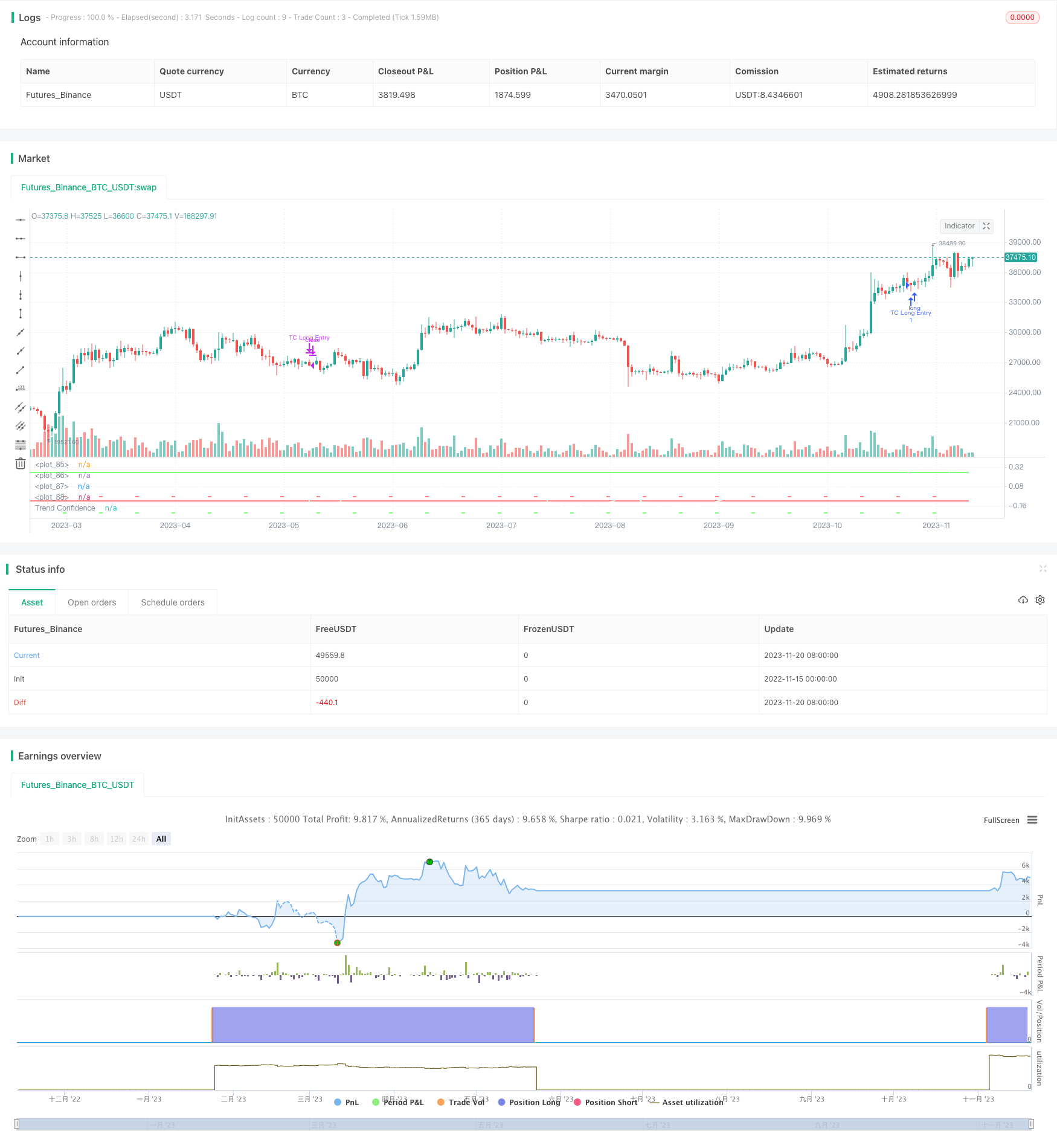
概述
该策略的主要思想是实现一个尽可能精确的趋势跟踪策略。它通过计算过去一定数量收盘价的“置信度”来判断当前线性趋势的持续可能性。该策略假设,一旦置信度超过一定水平,正在发生的线性趋势更有可能持续下去。
策略原理
该策略通过普通线性回归方法计算过去N个收盘价的线性拟合,获得线性拟合的斜率k和与收盘价的偏差标准差σ。然后定义趋势置信度为k/σ。
当趋势置信度超过“做多入场”阈值时,做多;当下跌到“做多平仓”阈值时,平仓。同理,当趋势置信度低于“做空入场”阈值时,做空;当超过“做空平仓”阈值时,平仓。
这样,它可以过滤掉野性的、不遵循明确线性趋势的价格变动带来的信号。
优势分析
该策略结合了趋势跟踪和统计学中的线性回归方法,でき避免追随短期价格震荡,只跟随长期趋势,从而获得较低的交易频率和较高的胜率。
该策略参数调优空间大,可以通过调整参数适用于不同品种和时间周期,实现良好的泛化性。
风险分析
该策略存在被套利的风险。当价格出现明显趋势反转时,策略会产生较大亏损。此外,参数设置不当也会导致过度交易或错失良好交易机会。
可以设置止损来控制亏损风险。同时,必须慎重评估参数的选择,避免过度优化。
优化方向
该策略可以在以下方面进行进一步优化:
增加止损、止盈逻辑,以锁定利润、控制风险
增加参数自适应优化模块,使参数可以动态调整
增加机器学习模型判断趋势反转点,进一步提高策略胜率
尝试不同品种、时间周期的适配性,提高泛化能力
总结
该策略总体上是一个立足长期趋势、控制风险的量化策略。它融合了趋势跟踪和线性回归方法,可以过滤噪音交易信号。通过参数调优,它可以很好地适配不同品种和周期,是一种值得重点研究和改进的有效策略。
策略源码
/*backtest
start: 2022-11-15 00:00:00
end: 2023-11-21 00:00:00
period: 1d
basePeriod: 1h
exchanges: [{"eid":"Futures_Binance","currency":"BTC_USDT"}]
*/
// This source code is subject to the terms of the Mozilla Public License 2.0 at https://mozilla.org/MPL/2.0/
// © carefulCamel61097
// ################################################################################################
// "This is a trend following strategy that performed very well on the past 5 years"
// "Intended to be used on BTC-USDT, 4hr timeframe"
// "A factor 2 Leverage can be added by changing Order Size to 200% of equity"
// "Higher leverage is not recommended due to big drawdowns"
// "Also seems to work on 1D timeframe, although ideal parameters may be different"
// "Also seems to work on ETH-USDT and some other altcoins, although ideal parameters are different"
// ################################################################################################
//@version=5
strategy("Trend Following based on Trend Confidence", overlay=false )
// Inputs
source = input(close)
since = input(timestamp('2000-01-01'), title='Start trading interval')
till = input(timestamp('2030-01-01'), title='End trading interval')
length = input(30, title='Length')
longs_on = input.bool(true, title='Longs')
shorts_on = input.bool(true, title='Shorts')
// Parameters for best performance 2018 - 2022
// long_entry = input.float(0.26, step=0.01, title='Long entry threshold')
// long_exit = input.float(-0.10, step=0.01, title='Long exit threshold')
// short_entry = input.float(-0.24, step=0.01, title='Short entry threshold')
// short_exit = input.float(-0.04, step=0.01, title='Short exit threshold')
long_entry = input.float(0.25, step=0.01, title='Long entry threshold')
long_exit = input.float(-0.10, step=0.01, title='Long exit threshold')
short_entry = input.float(-0.25, step=0.01, title='Short entry threshold')
short_exit = input.float(-0.05, step=0.01, title='Short exit threshold')
stop_loss = input.float(10, step=1, title='Stop loss (percentage)') / 100
// Trend Confidence
linreg = ta.linreg(source, length, 0)
linreg_p = ta.linreg(source, length, 0+1)
x = bar_index
slope = linreg - linreg_p
intercept = linreg - x*slope
deviationSum = 0.0
for i = 0 to length-1
deviationSum := deviationSum + math.pow(source[i]-(slope*(x-i)+intercept), 2)
deviation = math.sqrt(deviationSum/(length))
slope_perc = slope / source[0]
deviation_perc = deviation / source[0]
trend_confidence = slope_perc / deviation_perc
// Strategy
in_interval = true
sl_long = strategy.position_avg_price * (1 - stop_loss)
sl_short = strategy.position_avg_price * (1 + stop_loss)
if in_interval and longs_on and ta.crossover(trend_confidence, long_entry)
strategy.entry("TC Long Entry", strategy.long)
strategy.exit("TC Long Exit", stop=sl_long)
if in_interval and longs_on and ta.crossunder(trend_confidence, long_exit)
strategy.close("TC Long Entry")
if in_interval and shorts_on and ta.crossunder(trend_confidence, short_entry)
strategy.entry("TC Short Entry", strategy.short)
strategy.exit("TC Short Exit", stop=sl_short)
if in_interval and shorts_on and ta.crossover(trend_confidence, short_exit)
strategy.close("TC Short Entry")
// Plots
plot(trend_confidence, "Trend Confidence", color.rgb(255, 255, 255))
plot(long_entry, "", color.rgb(0, 255, 0), linewidth=1)
plot(long_exit, "", color.rgb(255, 0, 0), linewidth=1)
plot(short_entry, "", color=bar_index % 10 == 0 ? color.rgb(0, 255, 0) : #00000000, linewidth=1)
plot(short_exit, "", color=bar_index % 10 == 0 ? color.rgb(255, 0, 0) : #00000000, linewidth=1)